
Khosrow I, traditionally known by his epithet of Anushirvan, was the Sasanian King of Kings of Iran from 531 to 579. He was the son and successor of Kavad I.
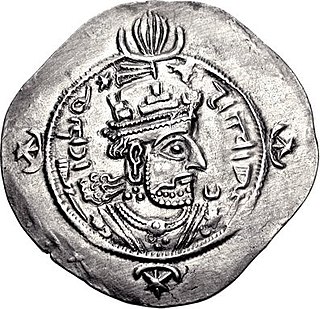
Kavad II was the Sasanian King of Kings of Iran briefly in 628.

Khosrow II, commonly known as Khosrow Parviz, is considered to be the last great Sasanian king (shah) of Iran, ruling from 590 to 628, with an interruption of one year.

Gonabad is a city in, and the capital of, the Central District of Gonabad County, Razavi Khorasan province, Iran, and also serves as capital of the county.
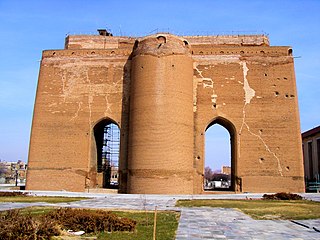
Arg of Tabriz, is the remnants of a large acropolis fortification and city wall in downtown Tabriz, Iran. Its structure is visible from far distances in downtown Tabriz, if not blocked by the newly erected highrise buildings.

Damghan is a city in the Central District of Damghan County, Semnan province, Iran, serving as capital of both the county and the district.

Khosrow and Shirin is the title of a famous tragic romance by the Persian poet Nizami Ganjavi (1141–1209), who also wrote Layla and Majnun. It tells a highly elaborated fictional version of the story of the love of the Sasanian king Khosrow II for the Armenian princess Shirin, who becomes queen of Persia. The essential narrative is a love story of Persian origin which was already well known from the great epico-historical poem the Shahnameh and other Persian writers and popular tales, and other works have the same title.

Bahrām Chōbīn or Wahrām Chōbēn, also known by his epithet Mehrbandak, was a nobleman, general, and political leader of the late Sasanian Empire and briefly its ruler as Bahram VI.
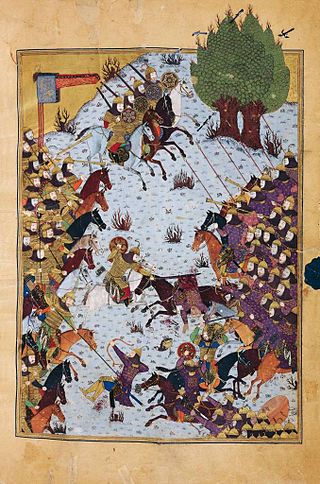
Kay Khosrow is a legendary king of Iran of Kayanian dynasty and a character in the Persian epic book, Shahnameh. He was the son of the Iranian prince Siavash who married princess Farangis of Turan while in exile. Before Kay Khosrow was born, his father was murdered in Turan by his maternal grandfather Afrasiab. Kay Khosrow was trained as a child in the desert by Piran, the wise vizier of Afrasiab. His paternal grandfather was Kay Kāvus, the legendary Shah of Iran who chose him as his heir when he returned to Iran with his mother. The name Kay Khosrow derives from Avestan 𐬐𐬀𐬎𐬎𐬌 𐬵𐬀𐬊𐬯𐬭𐬀𐬎𐬎𐬀𐬢𐬵𐬀 Kauui Haosrauuaŋha, meaning "seer/poet who has good fame".
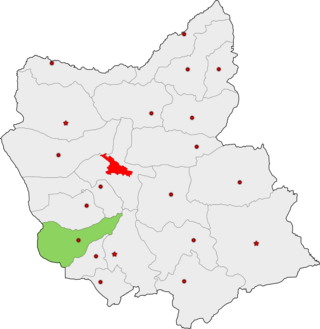
Ajab Shir County is in East Azerbaijan province, Iran. Its capital is the city of Ajab Shir.

The Kayanians are a legendary dynasty of Persian/Iranian tradition and folklore which supposedly ruled after the Pishdadians. Considered collectively, the Kayanian kings are the heroes of the Avesta, the sacred texts of Zoroastrianism, and of the Shahnameh, the national epic of Greater Iran.
The former city of Dehistan/Mashhad-i Misrian, now in the Balkan Region of western Turkmenistan, was a major economic center from the 10th to the 14th centuries CE. The city lay on an important trade route of the states comprising Greater Iran.
Khosrow Khani is a village in Beyranvand-e Jonubi Rural District, Bayravand District, Khorramabad County, Lorestan Province, Iran. At the 2006 census, its population was 88, in 15 families.

Qobad Bazn is a village in Kahak Rural District, Kahak District, Qom County, Qom Province, Iran. At the 2006 census, its population was 613, in 174 families.
Khosrow Shir is a village in Miyan Jovin Rural District, Helali District, Joghatai County, Razavi Khorasan Province, Iran. At the 2006 census, its population was 384, in 100 families.
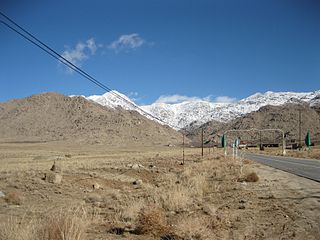
Pandar is a village in Zardeyn Rural District, Nir District, Taft County, Yazd Province, Iran. As of the 2006 census, its population was 330 across 92 families. Pandar is on the eastern slopes of Shirkooh Mountain. Alongside historic cities and in vast places in Iran, there are unknown villages that are an unmatched memory for the lasting effects of cultural heritage. Pandar Village is one of these lasting villages, which is on the hillside and beside the Yazd desert for many years, which is beautiful and has attracted many tourists. Pandar is a beautiful, mountainous place with numerous historical sites. According to the view of the botanical experts, the village has a treasure trove of medicinal herbs. The village is located six kilometers east of Nir and located on the northern side of the area of Poshtokh. Pandar is located in the vicinity of many villages and fields. The village of Shir Kuh is located in the southeast of Pandar, about 1 km away, Mahmoodabad farm in the south of Pandar, 1.5 km away, as well as the village of Mahdiabad and Golgazar farm (Golgodar), southwest of Pendar. Pander ends on the north to the mountain, stretching along them to Menashed, Nir, Yazd, Tazerjan and Dehbala.
Tall Khosrow was a village in Sarrud-e Jonubi Rural District of the Central District of Boyer-Ahmad County, Kohgiluyeh and Boyer-Ahmad province, Iran.

Fariburz is an Iranian hero in Shahnameh, the national epic, of Greater Iran. He is son of Kay Kavus and brother of Siyâvash. He appears in the story of Mazandaran, the story of Sohrab and the story of Siavash. But his most important role is when Giv brings Kay Khosrow back to Iran. Tous, another Iranian hero is opposed to the rulership of Kay Khosrow in favor of Fariburz, because Kay Khosrow is grandson of Afrasiab. Kay Kavus, unable to choose between Kay Khosrow and Fariburz, decides to give the rulership to the one who can successfully capture a fortress in Ardabil. Tous and Fariburz are unable to take the fortress, while Giv and Kay Khosrow are able to take it easily. Kay Khosrow thus becomes the king of Iran. Fariburz thereafter obeys Kay Khosrow and participates in the wars between Iran and Turan. Fariburz married Farangis, Kay Khosrow's mother. Fariburz is among those heroes that disappear in the snow after Kay Khosrow's ascend.





































